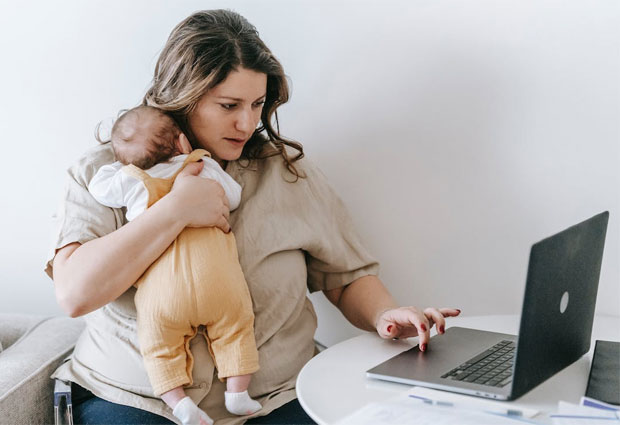10 Postpartum Body Changes: What to Expect and How to Cope

10 Postpartum Body Changes: What to Expect and How to Cope
The sweet scent of your newborn fills your home with so much love. As a new mother, baby care occupies your time every day. But sometimes, when you’re alone, you notice the changes in your body and yo might compare yourself to how you looked and felt before your pregnancy. This article will guide you through the physical changes and equip you with effective coping strategies, ensuring you embark on the postpartum journey with confidence and resilience.
Expected postpartum body changes and how to cope with them
The physiological transformations that begin during pregnancy persist beyond childbirth, leading to a myriad of changes in your postpartum body.
Here are 10 common changes your postpartum body goes through:
Breast Changes
1. Breast Engorgement
After childbirth, breast changes include temporary swelling, soreness, and engorgement due to milk production. The breasts may also sag due to the stretched skin, even if you don’t breastfeed.
Cold compresses and a supportive bra can alleviate discomfort, while warm showers, regular breastfeeding, gentle massage, and pumping can assist with milk flow.
2. Nipple Pain
This is quite common, especially if there are cracks in the nipple.
Proper breastfeeding techniques and moisturizing creams can help with nipple cracking and pain. You can also speak to a lactation nurse for guidance.

Perineum and Labour Recovery
3. Afterbirth Pains
It’s common to experience postpartum cramps as the uterus contracts and shrinks back to its normal size. Evidence indicates that complete uterine involution in women takes place for about 6 weeks or more.
This can be managed with over-the-counter pain relief under the guidance of a healthcare provider.
4. C-Section Recovery
For those who have undergone a Caesarean section, you should expect soreness around the incision site, which may last days to a few weeks. Most C-section scars fade to a pencil-thin line in 12 to 24 months.
Managing incision soreness involves pain medication, support from others and adequate rest.
5. Vaginal Discharge
Postpartum vaginal discharge, commonly referred to as lochia, is essentially a mixture of residual blood, mucus, and tissue from the uterus. Lochia usually lasts about a month or even longer, reflecting the natural process of uterine involution.
Avoid using tampons, as they can pose infection risks and cause discomfort. Opt for durable pads and change them after every few hours.
6. Perineal Soreness
Those who have a vaginal delivery might experience perineal soreness. This might be from a perineal tear or an episiotomy, both of which need about 6 weeks to heal. Cold packs and proper hygiene can alleviate perineal soreness. Your doctor may also prescribe pain relief medication and antibiotics.
7. Vaginal laxity
Vaginal laxity is a common self-reported complaint and it may take a little while to feel like yourself again down there. You can try the Kegel exercise as this is very useful. There are also nonsurgical options, such as minimally invasive vaginal rejuvenation and surgical ones like vaginoplasty.
The cost of vaginal rejuvenation varies based on factors such as the specific procedure, such as labia reduction for example, its extent, geographical location and provider expertise. It is usually not covered by insurance and typically ranges from $500 to $10,000.

Body Adaptations
8. Weight gain
Postpartum weight gain is often attributed to reduced activity and increased food intake. Losing this weight may take up to a year and a gradual approach is recommended.
Combining exercises that target multiple muscles with a well-balanced, high-protein, high-fiber diet is suggested by experts.
9. Skin changes
Skin changes in the postpartum period are common and varied. Melasma, often known as the “mask of pregnancy,” affects up to 70% of new mothers, resulting in dark patches on the face.
These usually fade in a few months, but your doctor can also prescribe limited use of tretinoin, hydroquinone or corticosteroids.
Stretch marks are influenced by genetics, pregnancy hormones, weight gain and usually fade over months to years. Tretinoin cream may be useful.
10. Hair loss
Postpartum hair loss is a common occurrence attributed to hormonal changes. During pregnancy, hair often thickens, and the excess hair is shed after childbirth. This shedding phase usually normalizes within 3 months. Consult a doctor if hair loss persists significantly.
Understanding these postpartum changes across various systems can empower new mothers to navigate this transformative period with resilience and confidence.
Final note
Physical recovery is a gradual process and individual experiences may differ. While there are no certain timelines for postpartum body changes, the good news is that most of these changes are not permanent. The key is to be patient and enjoy your new and amazing life.
Guest Article. About the Author – Ferdinand Obi (MBBS, MWACS, FMCOG, MPH): Bridging medicine and words.




